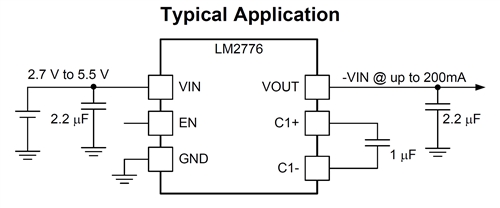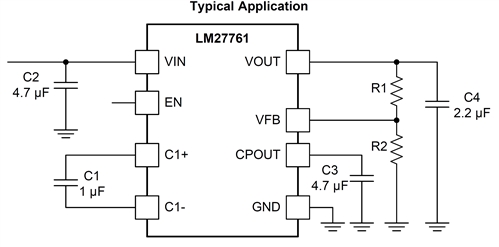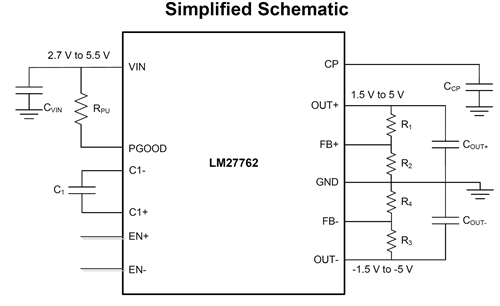SSZT970 august 2017 DAC38RF80 , LM2776 , LM27761 , LM27762 , TPS60400
Do you have a need for a negative voltage? If you are responsible for designing an amplifier, audio system, data converter or gallium nitride (GaN) driver, you may feel all alone in your quest to provide the proper power solution for your system.
A voltage below ground can be quite cumbersome to create given the small number of voltage inverters on the market. Why not simplify your task with a charge-pump solution? Figure 1 shows the simplest way to make a negative rail with the LM2776.
 Figure 1 The LM2776 Inverting Charge
Pump Simply Inverts Its Supply Voltage
Figure 1 The LM2776 Inverting Charge
Pump Simply Inverts Its Supply VoltageCharge pumps are one of the simplest power supplies, since no inductors are required. Useful at lower powers, capacitors alone store and transfer the converted energy. Combined with a small-outline transistor (SOT)-23 package, the three required capacitors make a very easy solution.
While very efficient (over 90% is possible), a charge pump does not provide a regulated output voltage. It is so simple that it just inverts the supply voltage without any feedback loop. This poses two possible problems: the output voltage varies as the load varies due to the drops across the charge pump’s output impedance, and the output voltage may be too high (that is, too negative) for a specific load. To overcome these challenges, you’ll need a voltage regulator after the charge pump’s inverting stage.
The LM27761 provides exactly this function by integrating – along with an inverting charge pump – a negative low-dropout regulator (LDO). Not only does this LDO regulate the negative output voltage, but it helps achieve additional noise rejection to produce a very clean voltage suitable for powering sensitive analog loads such as data converters. Figure 2 shows the LM27761, with its extra capacitor required for the LDO output and two feedback resistors to set the output voltage.
 Figure 2 The LM27761 Inverting Charge
Pump Includes an LDO to Regulate Its Negative Output Voltage
Figure 2 The LM27761 Inverting Charge
Pump Includes an LDO to Regulate Its Negative Output VoltageIn some applications, such as headphones, the sensitive analog load requires two voltages: one positive and one negative. Both rails may need to be clean. If the input power source (such as a single-cell lithium battery) has some noise present on it, you will also need a positive LDO to bring the noise down to an acceptable range for the load. While the noise may originate from other switching power supplies powered from the same input source (the same battery), the LM27762 is sure to clean this up with its integrated positive LDO.
Figure 3 shows the solution, which contains two LDOs and one inverting charge pump inside a single device, to power sensitive loads that require both a positive and negative rail.
 Figure 3 The LM27762 Inverting Charge
Pump Includes a Positive and a Negative LDO
Figure 3 The LM27762 Inverting Charge
Pump Includes a Positive and a Negative LDOAnd there you have it: the LM2776, LM27761 and LM27762 charge pumps meet whatever negative voltage needs you may have. See the Additional Resources section for more information on inverting charge pumps and voltage inverters for both higher- and lower-power applications.
Additional Resources
- Check out these other blog posts:
- Need an even lower-power inverting charge pump? Check out the TPS60400 family.
- Need a higher-power voltage inverter? Switch to an inverting power module with these reference designs:
- See examples of designs using these inverting charge pumps: